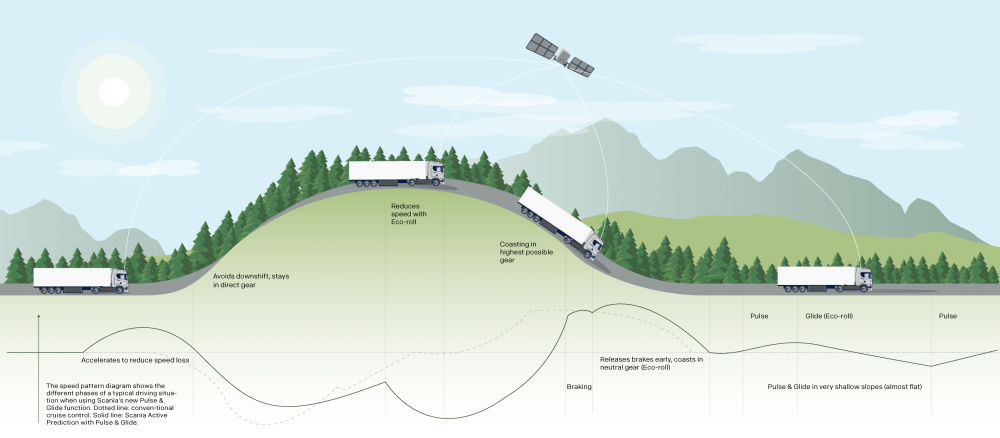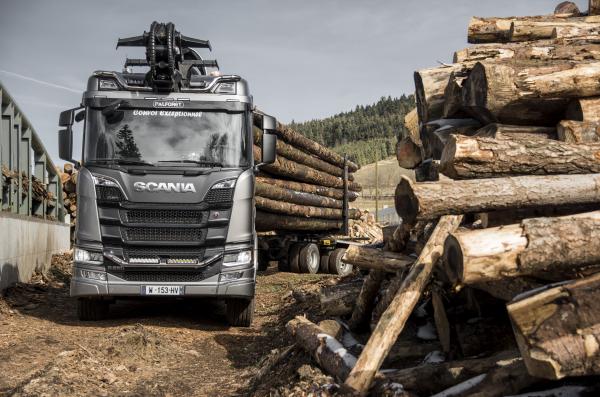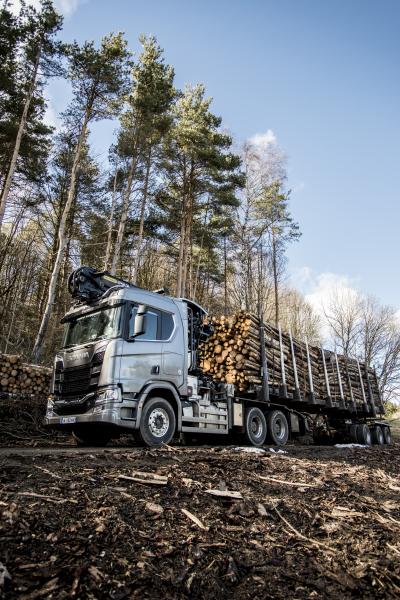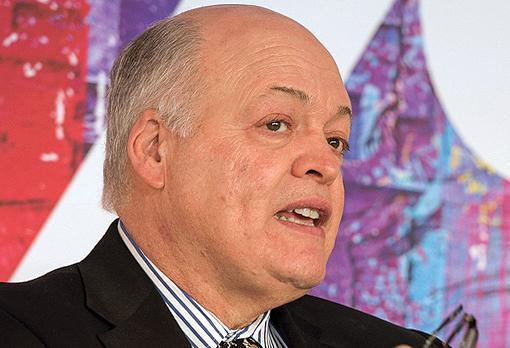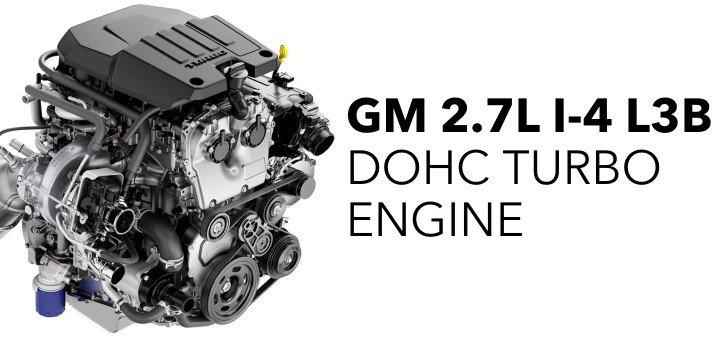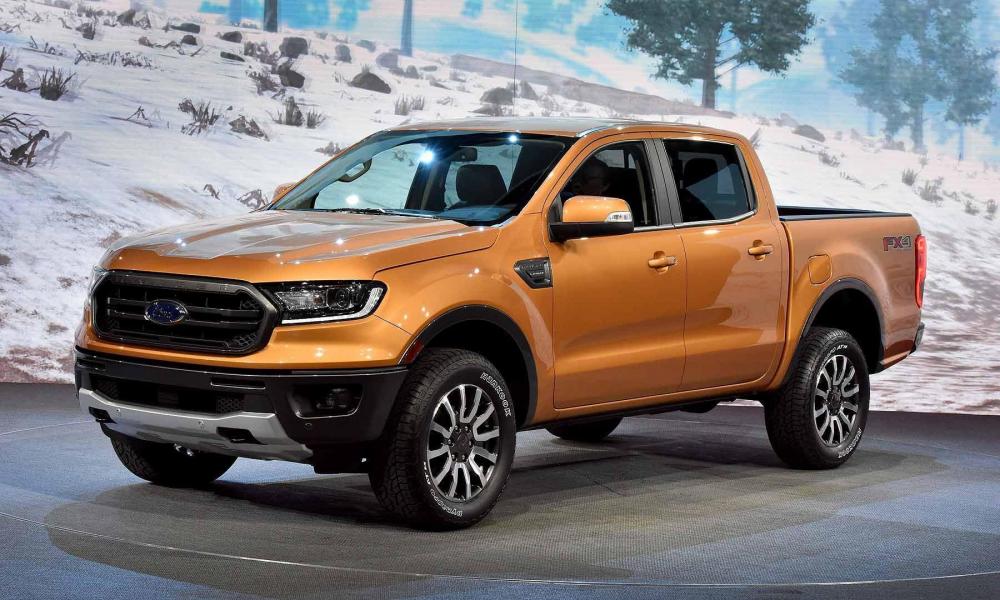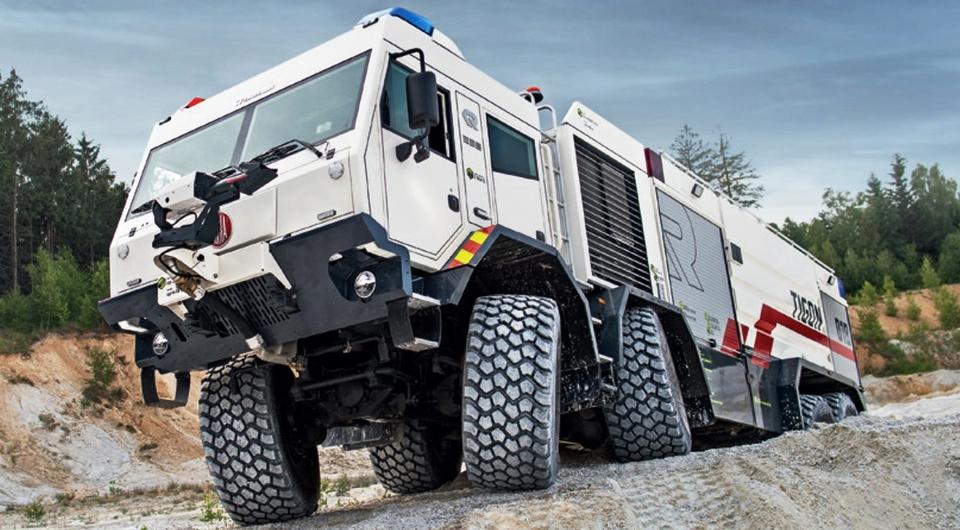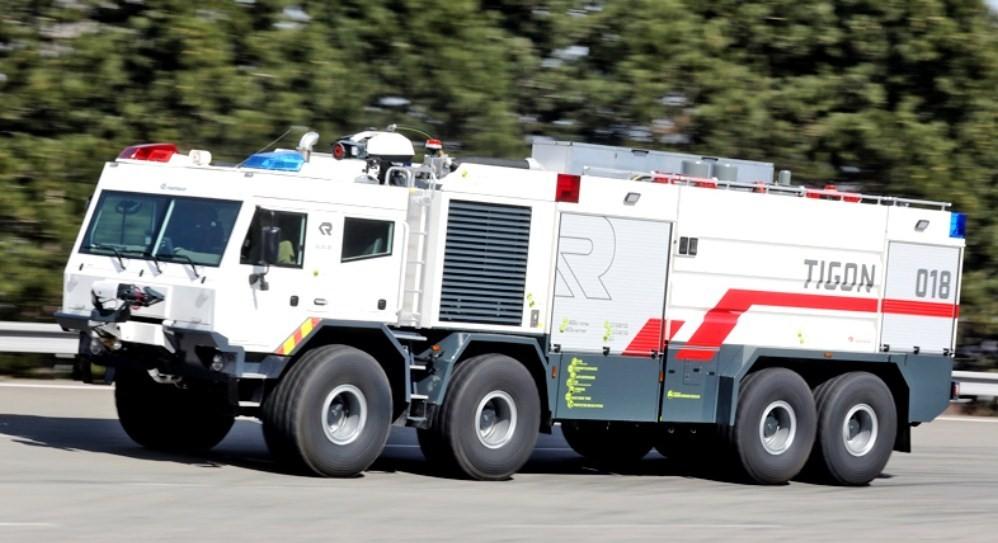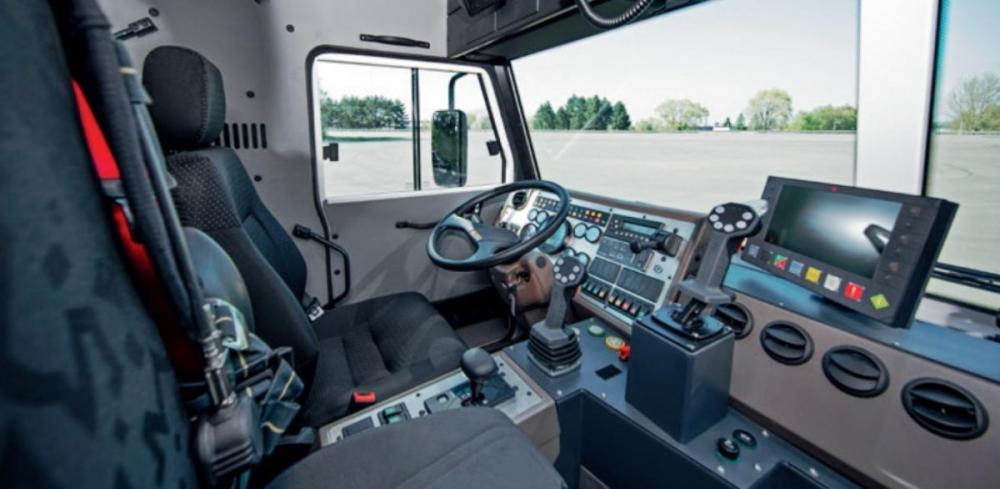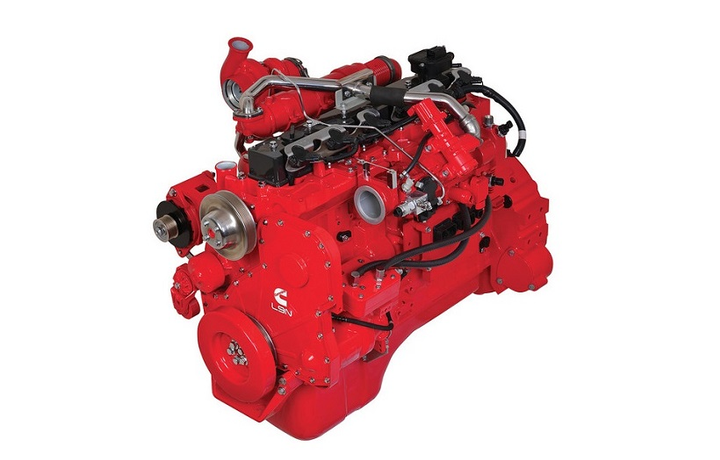
kscarbel2
Moderator-
Posts
18,868 -
Joined
-
Days Won
114
Content Type
Profiles
Forums
Gallery
Events
Blogs
BMT Wiki
Collections
Store
Everything posted by kscarbel2
-
Why not make the most of the truck’s kinetic energy to save fuel? That’s what Scania’s new Pulse & Glide functionality does – even on flat road stretches. Connectivity has changed the conditions for long haulage transport radically. In recent years, a number of new efficiency-boosting services and functions have been launched thanks to the new technology. An example is the new, smart cruise control Scania Active Prediction that was launched in 2012. The system uses topographical map data and GPS technology to determine the characteristics of the road three kilometres ahead. “Based on this data, the system selects gearing and speed strategies for the lowest possible fuel consumption. When compared to a conventional cruise control, we saw that Active Prediction could save between 5–7 percent fuel, with just around 0.9 percent lower average speed,” says Fredrik Roos, powertrain control strategist at Scania. But Scania’s engineers didn’t stop there. Fredrik Roos and colleague Mikael Ögren formed a team that continued the development. The team focused on the algorithms that calculate how the vehicle’s kinetic energy can be used to eco-roll with the gears in neutral. “Through simulations of different speed profiles we could see that patterns where the speed was increased just before the eco-roll phase was beneficial for the fuel consumption. That’s what we wanted the system to do, automatically,” Roos says. The result of the team’s efforts, Pulse & Glide, was launched in 2017, adding new functionality to Scania Cruise Control with Active Prediction (CCAP). In the latest version of CCAP, eco-roll can be used even on gradients that under normal circumstances are not steep enough to maintain speed. Longer time for eco-roll “By being able to increase speed – Pulse – and then freewheel – Glide – the collective time that the vehicle uses eco-roll can be considerably increased,” says Roos. “On suitable stretches of road, the new function alone can contribute to additional fuel savings of up to 0.5 percent.” According to Fredrik Roos, the complete active prediction system’s potential is best realized when driving truck and trailer combinations between 20 and 40 tons in hilly terrain and relatively light traffic. But Scania’s new system with Pulse & Glide has proved its worth also on flat road stretches, with a total fuel saving of 1.5 percent compared to a standard cruise control. Now, Roos’ team has started looking at future challenges. “We are continuously developing the algorithms to also being able to avoid unnecessary braking in situations where traffic is dense and you have short distances between the vehicles. This scenario will become more common as we move towards more convoy driving, or platooning. We are also looking into how we can optimize the system for hybrid powertrains.” .
-
Scania Group Press Release / August 14, 2018 It takes a special kind of truck to transport over 50 tonnes of timber from a felling site to the sawmill along a hilly forest road – especially with a crane with a 10-metre boom in tow. That’s why Aurélien Rancon of Transports Rancon has invested in a Scania R 650 V8 specially adapted to his needs. High in the hills of the Haute-Loire in southern France, Aurélien Rancon, director of Transports Rancon, is delicately picking up 16-metre logs one at a time, and stacking them onto the trailer of his Scania R650. The whole process is apparently painless – like any job when carried out with the right tools. And Rancon is more than satisfied with his truck and Palforet crane; for his 22-tonne V8 is strong and reliable, the crane has a grappling hook that means business, and both obey his every command. Powerful, stable and safe, the truck has no problem overcoming pitfalls on the road and can negotiate an 18 percent incline with ease, but Rancon still approaches every forest road with caution. “For us loggers, the first three miles are the most dangerous,” he says. “These roads are not built for a 57-tonner!” Sometimes his skills are tested to the limit by the snow, ruts and narrowness of road, as well as the weight and length of the load. Thanks to the second wheel which controls his Faymonville three-axle trailer, he feels confident: “It is absolutely essential for narrow bends or manoeuvring in the forest. I have a control screen that shows me everything happening behind.” Rancon will need to transport this batch of timber to the Celle sawmill about 12 miles from away: one of many of the runs he will be doing for them this week. Transports Rancon known for a timely delivery Simon Guironnet, timber buyer at the mill, says: “Transports Rancon are punctual and serious about the job. They understand that a reliable truck guarantees delivery of the timber.” With an annual turnover of EUR 700,000, Transports Rancon employs three members of staff including two drivers, and operates four trainers and four vehicles including three Scania trucks. Originally tailor-made for an exhibition, Transports Rancon’s latest Scania truck was adapted to their particular requirements. “To perform the work, we need power and torque,” says Rancon. Julien Sauron, Commercial Manager, Trucks Services and Distribution, and a Scania distributor says: “This is the ideal model for extreme conditions with balanced power, performance and fuel consumption, which is really low for a V8. The V8 Euro 6 engine is remarkable for its simplicity, and it meets the levels of reliability that Aurélien requires perfectly.” The pair know each other well because this is not the first Scania that Rancon has purchased. But this latest truck displays exceptional character including the dual chassis, enhanced braking system, the most powerful hydraulic retarder in the range (R4100), without forgetting the V8 engine. With a front axle capacity of 10 tonnes and two rear axles of 13 tonnes each, the vehicle has been approved for a gross combination weight rating of 70 tonnes and for carrying 57 tonnes of round timber. “It’s quite exceptional, even on board.” says Rancon. “And the visibility is astonishing.” Turning point Following an industrial accident that kept him off the road for several months, driving comfort is particularly important to Rancon, he appreciates the ergonomics of his next-generation cab. “In the new Scania, I no longer feel any back pain,” he says. It was this accident that led the young business owner to a strategic turning point: “Being bed-ridden, I only had the internet to keep me occupied. I started looking at new markets. The large Belgian and German sawmills were starting to invest in the French market because of its fuel diversity and the abundance of raw materials. I seized this opportunity and started to develop with them.” Sauron on Scania’s services Since a vehicle out of action represents a loss in earnings, “When a logger phones you, you know that you have to act immediately,” says Sauron. After-sales care is the key. “There’s no room for error! The vehicles are so specific, we cannot provide a courtesy vehicle if one is out of action so anticipating a breakdown is essential. A part ordered before 4pm will be delivered the next morning, which means we can act quickly. Racon appreciates this proactive approach to after sales: “I know I can count on Julien.” .
-
The Dubai Road Express | Legends of Long Haulage
kscarbel2 replied to kscarbel2's topic in Trucking News
Dubai Road Express Film – Full Movie in High Definition Scania Group Press Release / August 15, 2018 In 1976, Scania commissioned a film to document the maiden trucking journey between Norway and Dubai on a route called the Dubai Road Express. More than four decades later, this film has become a piece of history. The year prior, Norwegian trucking company Johan Evensen & Sønner had completed its last of 106 journeys to Bandar Abbas on the southern coast of Iran, and was looking for new opportunities. It was the next year, when the tanker Serpens Constellation had an unexpected breakdown in the middle of the Atlantic, that Jan was given the mission of a lifetime. A necessary spare part, made in Norway, needed to be delivered to Dubai, where the ship could pick it up while en route into the Persian Gulf. For the drivers of such routes, leaving home meant being away from their families for weeks at a time, often without knowing exactly when they would be back or what challenges they would encounter along the way. In the end, the Dubai Road Express turned out to be short-lived. Once the inaugural trip was over, transport company Johan Evensen & Sønner made the decision to cancel the route. The loose sand between Doha and Dubai, accompanied by relentless heat that disabled important support systems, meant the route was just not worth the trouble. . -
Why you should beware of your smartphone—and the invisible blue light it emits Alessandra Malito, Market Watch / August 15, 2018 Blue light is everywhere. It’s emitted by computers, televisions and smartphones. It’s also the cause, in some cases, for accelerated blindness and eye disease, according to a new study. Constantly looking at digital devices kills cells in the eye’s retina, and can lead to macular degeneration, an incurable eye disease that usually begins when people are in their 50s or 60s, a recent University of Toledo study found. Blue light can cause a “poisonous” chemical reaction in the eye’s photoreceptor cells and, when those cells die, they’re gone forever. The good news: There’s a way to prevent the cells from dying. Ajith Karunarathne, assistant professor in the department of chemistry and biochemistry at the University of Toledo, found one type of molecule — called the antioxidant alpha tocopherol, which is derived from Vitamin E — can stop the poisonous reaction. As people get older, it’s harder to fight eye disease. Karunarathne said he hopes this research leads to the invention of preventative measures, such as eye drops to protect the retina. Blue light in the dark can be especially dangerous, previous studies show, and this type of light has been linked to cancer, diabetes, heart disease and obesity, according to a Harvard University study. The reason is unclear, but researchers have associated exposure to blue light with a decrease in melatonin, the hormone that affects circadian rhythm — the 24-hour human body clock. When the circadian rhythm is off, so are blood sugar levels, which can lead to obesity and diabetes. Screen time is also associated with depression among adults. The problems connected with blue light may only get worse. American adults spend more than 11 hours a day looking at screens and check their phones every 10 minutes on average. Amazon sells glasses that block the damaging effects of blue light. They cost between $9 and $60. Refrain from looking at digital devices in the hours before bedtime, and expose yourself to bright lights during the day, which affect the way you sleep at night, as well as your mood and alertness, the Harvard study found. And if you’re still constantly looking at a screen, remember to blink regularly. Focusing on a screen decreases reflexes and tear production, which causes dry eyes, according to the College of Optometrists. In the meantime, try the 20-20-20 rule: every 20 minutes, you look 20 feet away for 20 seconds, to give your eyes a break and increase blinking.
-
Ford's blue sky CEO has investors treading water Chris Bryant, Bloomberg / August 15, 2018 In a fractious call with analysts last month, during which Ford Motor Co.'s management were once again lambasted for their vagueness about planned restructuring measures, Chief Financial Officer Bob Shanks did make at least one revealing comment: "We swim in the water with ankle weights, big ones…we want to get them off so that the real underlying strength of this company can come through." He was referring, of course, to Ford's unprofitable international operations and a portfolio that's still too heavily skewed towards unpopular sedans -- factors that contributed to a shock profit warning. But with Ford's shares falling by one quarter so far this year, investors must be wondering whether that's the extent of the automaker’s surplus baggage. Two more potential problems – leadership and liquidity (namely, Ford's capacity to pay dividends) – have also come into sharp focus recently. Neither will be addressed in a hurry, and that’s partly because of the influence of the founding family. Dividend questions First, liquidity: Ford is committed to paying about $3 billion in dividends this year. In view of Ford’s rapidly deteriorating operating performance and the litany of longer-term challenges it faces, that’s probably too high. The 6.3 percent dividend yield -- a level that often indicates a payout cut is in the offing -- suggests plenty of investors think the same. Not so long ago, some analysts were complaining Ford was too stingy with its cash. So what’s changed? Outside the U.S., Ford isn’t generating returns that exceed its cost of capital. Including dividend and pension contributions, Ford's automotive unit consumed about $1 billion of cash last year and this year isn't shaping up any better. Management have, somewhat belatedly, announced a mammoth restructuring that’s set to cost about $7 billion in cash terms over the next four years or so. The company's annual capital expenditures bill is about $7.5 billion, plus it is also having to invest plenty in autonomous vehicle research. Suddenly, things look tight. True, Ford's balance sheet remains in decent-ish shape now -- the autos unit has about $9 billion of net cash. But a more sudden sales slowdown would cause this to bleed cash due to Ford’s negative working capital position. Already, cash flow is deteriorating, and Berenberg analyst Alexander Haissl says the company will have to cut the dividend by one-third from next year. Hackett's management That’s liquidity, what about leadership? Chairman Bill Ford made a good call when he hired Alan Mulally from Boeing to run crisis-hit Ford in 2006. Mulally’s experience of cost-cutting at a hugely complex manufacturer proved invaluable at the automaker, which, unlike rival General Motors, didn’t require a government bailout. Hence, Ford watchers were probably reluctant to question the chairman’s decision last year to tap another outsider to run the company -- Jim Hackett, whose background is in office furniture. Ford described Hackett, who took up the helm in May 2017, as a "visionary." In other words, the sort of person needed to help the company make the leap to the autonomous and electric vehicle era. Hackett certainly isn’t to blame for the shortcomings in Ford's product lineup or China business, which pre-date his arrival, and he's had plenty of bad luck, too: Ford's very profitable U.S. truck operations were hit by a fire this year, the competitiveness of U.K. business is being upturned by Brexit, plus complying with Europe's tough new emissions rules is proving challenging. However, Hackett's encounters with the financial community -- peppered with buzzwords but short on details -- have been nothing short of disastrous. Furthermore, the speed at which Carlos Tavares has turned around Peugeot (and now Opel/Vauxhall) has made Hackett's repeated pleas for patience feel pretty inadequate. An article this week in The Wall Street Journal exploring Hackett's cerebral/baffling leadership style hasn't helped his cause either. Arguably, what Ford needs right now isn’t so much a visionary but someone who can also take swift, tough decisions. About half of the company's 200,000 workforce are in Ford's unprofitable overseas operations, which underscores the scale of the challenge. His frustration boiling over, Morgan Stanley analyst Adam Jonas outright asked Hackett last month whether he still expected to be running the company when the company finally gets around to holding a now-delayed capital markets day. But having waxed lyrical about Hackett’s qualities so recently, Bill Ford is hardly likely to withdraw his support now. Similarly, the chairman and his family aren’t likely supporters of a dividend cut. They control 40 percent of the voting rights thanks to a special class of stock, and depend on the lucrative payout. Shanks, the CFO, told Bloomberg on Tuesday the dividend isn’t at risk. With Ford’s management treading water, its investors are left to hope that the company’s many ankle weights don't cause it to drown. .
-
Sears CEO Lampert offers $400 million for Kenmore CNN Money / August 15, 2018 Sears Holdings, a cash-starved retailer which owns both the Sears and Kmart chains, has been shopping Kenmore and some of its other assets for years in an effort to raise additional money. Once a leader in sales of appliances, Sears has fallen on hard times due to sustained losses and falling sales. But the Kenmore brand is still widely seen as having value even if the Sears brand has been tarnished. Lampert wrote a letter to the Sears' board earlier this year suggesting now was the time to find a buyer for Kenmore. He said he was willing to make a bid for the brand and some of the other assets himself. Late Tuesday he released his latest letter to the Sears board, saying he was willing to pay $400 million for Kenmore and an additional $70 million to $80 million for the Sears Home Services division, also known as SHIP. Lampert said he's prepared to close on the deal in as little as 60 to 90 days. "Speed and certainty here are critical," he wrote in the letter. "We believe, therefore, that an expedited process is in the best interest of all parties involved." Sears declined to comment on Lampert's letter. Sears has lost $11.2 billion since 2010, its last profitable year. Sales have plunged 60% in that time. There were a total of 3,500 US Kmart and Sears stores when Lampert merged the two brands together in 2005. Now it has fewer than 1,000. And the company has sold many of the remaining stores to a real estate investment company also controlled by Lampert in order to raise money. It is paying rent on those stores to that real estate company. Sears Holdings also sold the Craftsman brand of tools to Stanley Black & Decker last year in a deal valued at $900 million. Lampert's letter repeated his past statements that he believes that Sears can still be turned around despite its financial problems. But he also proposed negotiating with lenders to try to extend the repayment schedule for some of Sears debt and engage in other forms of renegotiation. "Together, we believe these transactions would contribute to a comprehensive solution to create a viable and healthy Sears and would provide greater value to all stakeholders than would be available in pursuing other alternative," he said in the letter. The letter did not spell out those alternatives, but Sears warned last year that there is "substantial doubt" about its ability to stay in business long term. A bankruptcy reorganization could be one of those alternatives.
-
A look inside the Chevy Silverado's techy 4-cylinder engine Richard Truett, Automotive News / August 14, 2018 In the auto industry, imitation is a very high form of flattery, and many automakers copy each other's technologies, adding just enough of their own proprietary design and unique features to keep the patent attorneys from sending the cease-and-desist orders. So, it seems a bit strange that no other automaker has introduced a twin-turbo V-6 truck engine to compete with Ford's popular 2.7-liter and 3.5-liter EcoBoost motors in the Ford F-150. In fact, if you look at all the other full-size trucks from Toyota, Nissan, Ram and General Motors, you won't find a turbocharged gasoline engine available almost eight years after Ford rewrote the book on what a downsized and boosted truck engine could do. But that is about to change, although not in the way I expected. After Ford's twin-turbo V-6 proved truck buyers would pay a premium for a smaller, more powerful engine, I figured competitive V-6 turbos would be out in two or three years from at least Chevrolet and Ram. Turns out the next gasoline turbo engine will also go where no truck engine has gone before. That would be GM's new 2.7-liter turbocharged four-cylinder that can run on two cylinders at light loads. GM knows it can't put a four-cylinder engine in a vehicle designed for work if the engine can't flex some muscles and pull heavy loads. So, GM engineers packed the new engine with as much technology as I have ever seen in a four-cylinder engine. The list of engineering advances is long and includes a new BorgWarner dual volute turbocharger -- basically a turbo that admits exhaust gases from two ports to get the turbine spinning up to speed faster -- an electric water pump, cylinder deactivation and a very trick valvetrain. And that is why we are gathered here today, to talk about the valvetrain in the new engine. GM's aim with the 2.7-liter four-cylinder is to deliver a versatile engine that could deliver both high performance and high fuel economy under a wider range of operating modes. One of the chief criticisms of Ford's EcoBoost V-6 engines is that, under load, fuel economy suffers. GM is hoping to avoid such a large drop in fuel economy when the 2.7-liter is working hard. The way the "Tripower" valvetrain operates is one key to the engine's V-8-like 310 hp and 348 pound-feet of torque. That rating, by the way, makes the new engine one of the most powerful four-cylinders on the market, joining just eight other four-cylinder engines rated at 300 or more horsepower. Tom Sutter, chief engineer for the new engine, told me just cranking out a lot of horsepower wasn't the goal when the 2.7-liter was being created specifically for the retooled Silverado and GMC Sierra. If power was the only goal, GM could have simply increased the engine size, used a bigger turbocharger, or tweaked it in other ways. GM wanted high efficiency to go along with that power. So, in addition to focusing on thermal management and reducing friction, engineers created camshafts that operate in low lift, high lift and cylinder cut-off or active fuel management mode that shuts down two cylinders. But there's more. Not only does the camshaft vary the distance the intake valves open, but cam phasers adjust the timing of when the valves open. In short, GM has created what may be the industry's most versatile variable valve system. It's certainly the first in a truck engine. The intake camshaft, for example, uses electric device on the intake valves to move a pin to change the cam lobes. When merging on to a highway, the camshaft operates in high lift mode, which opens the intake valves 10.5 millimeters. When cruising on the highway at a steady speed, say 65 mph, the camshaft is in low lift mode and opens the valves 7.6 millimeters. When active fuel management is operating, the camshafts switch into no lift mode and keep the valves on cylinders two and three closed. "This is a game that's about making sure we've got not only the performance, which you get from the direct injection, turbocharger and high-lift cam profile, but you can operate at much more efficient conditions with no boost and low lift and AFM modes," says Sutter. "It gives you a lot more range in performance and efficiency. You really don't get the efficiency gain with just the turbocharger." Here's another interesting feature of the 2.7-liter engine: The effective compression ratio changes based on the amount of fuel and air admitted into the cylinders, says Joe Moon, one of GM's top valvetrain engineers. He said there are two ways to measure compression ratio. The geometric compression ratio is the measurement that accounts for the space above the piston and the stroke volume, which is fixed and does not change. The effective compression ratio changes, Moon said, based on the cam phaser position. What all this means is that the 2.7-liter has been outfitted with technology that expands the range where it delivers power and efficiency. GM recently let a few reporters test the new engine -- but only for short drives and without a payload in the bed. So, we don't know how the 2.7-liter performs under duress. If it pulls a heavy load but delivers slightly better fuel economy than a V-6 or V-8, the four-cylinder could be a tough sell. I can't see many Silverado buyers boasting about having a four-cylinder under the hood -- unless it is a real marvel, much like Ford's EcoBoost V-6 was when it debuted. "GM is priming their buyers with the new 2.7-liter four-cylinder as a sign of what is to come," says AutoPacific analyst Dave Sullivan. "Many smaller manufacturers will move to turbocharged six-cylinder engines. I could see the Lexus LS turbo V-6 end up in the Tundra or a version of Nissan's VR turbo six end up in a truck." Sutter told me GM easily met its fuel-economy goals for the new engine -- but he wouldn't say what they are. The engine's fuel-economy ratings have not been certified by the EPA. GM is expected to launch the new engine later this year. With the new Silverado shedding up to 450 pounds by using more aluminum and lighter-weight steel, combined with the lower weight of the four-cylinder engine vs. the V-6 it replaces, GM may have another game-changing truck engine on its hands. "I think GM takes it to another level with their 2.7-liter four," Sullivan says. "GM is saying to Ford, 'I see your V-6 and raise you an I-4!'" High horsepower four-cylinder engines: Infiniti QX50 VC-Turbo, 2.0-liter: 268 hp Chevrolet Camaro, 2.0-liter: 275 hp Alfa Romeo Stelvio, 2.0-liter: 280 hp Audi S3/ Volkswagen Golf R, 2.0-liter: 296 hp Jaguar F-Type, 2.0-liter: 296 hp Porsche Boxster 718, 2.0-liter: 300 hp Subaru WRX, 2.5-liter: 305 hp Honda Civic Type R, 2.0-liter: 306 hp Ford Mustang, 2.3-liter: 310 hp Volvo XC60, 2.0-liter: 316 hp Chevrolet Silverado/GMC Sierra, 2.7-liter: 310 hp Ford Focus RS, 2.3-liter: 350 hp Porsche Boxster S/Cayman S, 2.5-liter: 350 hp Mercedes-Benz CLA AMG45, 2.0-liter: 375 hp .
-
Ford's grand vision for Detroit train station to cost $740 million David Shepardson, Reuters / August 14, 2018 WASHINGTON -- Ford Motor Co. disclosed Tuesday it will spend $740 million on a project to revamp Michigan Central Station, Detroit's historic, dilapidated former rail station, as well as other neighborhood sites. Ford aims to turn the building into a campus of offices for up to 5,000 tech workers and software engineers focused on self-driving vehicles and ancillary technologies and services. Ford announced the project in June, but had not previously disclosed costs until a community meeting on Tuesday. The company said Tuesday in a statement it is "working with federal, state and local economic development groups and officials, seeking at least $250 million in tax or other incentives to support the development of the five Corktown sites Ford has purchased." Ford said total investment in the development of the train station and developing 45 acres of vacant land will cost approximately $740 million over the next four years. The figure includes acquiring the buildings and land as well as rehabilitation costs "which takes into account the requirements of restoring a historic building such as the train station," the company said. The automaker said the project costs do not require additional capital beyond what it previously committed as part of its overall 10-year campus plan in 2016. The Detroit train station closed in 1988 and fell into disrepair, becoming a symbol of the decline of the "Motor City." In the first half of the 20th century Detroit prospered and became America's fourth-largest city, its name synonymous with U.S. manufacturing prowess. But a riot in the 1960s and the oil shocks of the 1970s heralded decades of manufacturing decline. By mid-2017, Detroit's population had fallen to 673,104, according to the U.S. Census Bureau, from a peak of 1.8 million in 1950. In 2009 the Detroit City Council voted to tear the railway station building down, but it survived. .
-
Ford prices 2019 US market Ranger from $25,395 Michael Martinez, Automotive News / August 14, 2018 Ford is pricing the revived Ford Ranger about the same as the segment-leading Toyota Tacoma as it prepares to re-enter the midsize pickup market for the first time in about eight years. The 2019 Ranger, which goes on sale early next year, will start at $25,395 — including shipping — and will top out at more than $40,000. That's about the same as the Tacoma, which starts at $25,400 for 2018 models, but more than the Chevrolet Colorado and GMC Canyon. Pricing on the 2017 Colorado starts at $20,995, while the 2017 Canyon starts at $22,095. Ford said Tuesday it has opened dealer order banks and consumers can begin preordering the truck. The Ranger will come in three trim levels: XL, XLT and Lariat. Ford will sell two-door SuperCab and four-door SuperCrew configurations and offer both four-wheel drive and two-wheel drive for each configuration. The base XL 4x2 SuperCab with a 6-foot box will be priced from $25,395 with shipping, Ford said. The XL 4x2 SuperCrew with a 5-foot box starts at $27,615. The most expensive Ranger, a Lariat 4x4 SuperCrew, will be priced at $39,480. That figure can top $40,000 if buyers choose the FX4 off-road package, which is a $1,295 option. The FX4 package is offered on all 4wd models. It comes with the terrain-management system first offered on the F-150 Raptor that features four drive modes: normal, grass/gravel/snow, mud/ruts and sand. The package also includes a new "trail control," which acts as an off-road cruise control by accelerating or braking to maintain a set speed while traversing gravel or mountain trails. It's an extension of the automaker's hill-descent control, which controls braking on steep grades. The FX4 package will come with standard automatic emergency braking. Ford sells the Ranger in dozens of markets overseas. The 2019 Ranger has been specifically engineered for North America [???], company officials say. It will come with only one engine: a 2.3-liter [gasoline] EcoBoost mated to a 10-speed automatic transmission. The latest Ranger has a mostly steel body, axles made by Dana Inc., which supplies the Jeep Wrangler, and an exterior design similar to its larger F-series counterparts. During development, it went through the same torture tests as the F-150. It will include a number of tech features, such as a standard 4G-connected Wi-Fi hot spot, FordPass Connect and pre-collision assist technology. Ford stopped selling the Ranger in the U.S. in 2011. It was regularly among the segment's top sellers, including No. 1 as recently as 2004. Ranger sales routinely totaled more than 300,000 a year in the 1990s before fading in the early 2000s. U.S. sales of midsize pickups have climbed 18 percent this year after rising less than 1 percent in 2017. Photo gallery - http://www.autonews.com/apps/pbcs.dll/gallery?Site=CA&Date=20180114&Category=DETROIT_AUTO_SHOW&ArtNo=114009999&Ref=PH&Profile=1658 .
-
France Takes On Cellphone Addiction With a Ban in Schools The Wall Street Journal / August 13, 2018 A French law enacted last month is set to bar cellphone use by primary and middle school students, an effort to cut down on distractions in class and encourage play or reading during recess.
-
The Dubai Road Express | Legends of Long Haulage
kscarbel2 replied to kscarbel2's topic in Trucking News
-
Ford set a new 52-week low today of $9.42. It's telling when the market feels Hyster-Yale Materials Handling is worth $58 but Ford only $9.
-
Spec'ing a NEW MACK!! (Volmac)
kscarbel2 replied to Rolling18's topic in Modern Mack Truck General Discussion
No. The X12 (aka. ISG, ISX11.9) is an all new engine, introduced first in China at Foton-Cummins, in 10.5 and 11.8 litre versions. You're thinking of the Cummins' "Dakota", a decent 13 litre engine which, now upgraded, lives on at Dongfeng. -
Spec'ing a NEW MACK!! (Volmac)
kscarbel2 replied to Rolling18's topic in Modern Mack Truck General Discussion
Kenworth's T880 vocational chassis is available with the Cummins X12 in 350 to 425 horsepower ratings (the engine is rated up to 500hp). Peterbilt has offered the X12 (originally called ISX11.9) since 2010. Since then, the Model 520 refuse chassis is now available with the X12 as well. Paccar's DAF engines are good, but the truckmaker wisely provides customers with a choice, in the tradition of the North American market. -
Spec'ing a NEW MACK!! (Volmac)
kscarbel2 replied to Rolling18's topic in Modern Mack Truck General Discussion
https://cummins.com.au/sites/au/files/products/X12-Series-Brochure.pdf -
Spec'ing a NEW MACK!! (Volmac)
kscarbel2 replied to Rolling18's topic in Modern Mack Truck General Discussion
I'm seeing a lot of Kenworth product, including many tippers. And in the US market, 12 liters is all most people need "if" they're going for max fuel economy. . -
TATRA introduces new TIGON firefighting range
kscarbel2 replied to kscarbel2's topic in Trucking News
-
TATRA Trucks Press Release / August 6, 2018 TATRA Trucks has joined forces with Rosenbauer, one of the world's three largest fire apparatus manufacturers, to create the unique TIGON fire truck. The firefighting and rescue vehicle segment represents a significant portion of TATRA truck sales, presently 10% to 15% of annual production. TATRA firefighting trucks are highly valued among professionals and customers, not only in terms of high performance, but also in terms of driving stability and efficiency. The proven TATRA concept undercarriage and fully independent suspension’s pneumatic suspension system ensure high stability on any surface including high-speed smooth surfaces typical of industrial areas and airports. High handling stability Available in both four- and five axle configurations, a major goal in developing the all-new TIGON fire apparatus was to develop a special product with the greatest possible fire performance, no matter what terrain it would be forced to operate. The result is a unique vehicle suitable for any firefighting task, including those that go beyond existing standard vehicles. At first glance, the four-axle TIGON impresses with its 24.00R21 tires and 4490 mm wheelbase. It has an overall length of 12,285 mm, 2900 mm width and height of 3700 mm. The best The overall width of the vehicle suggests that it is the ultimate firefighter special designed for interventions primarily outside conventional communications in industrial areas. The 43 tonne vehicles’s impressive acceleration and high speed is achieved via the use of a Volvo TAD164VE-B six-cylinder Tier 2 emission engine. It is capable of delivering a maximum output of 515 kW / 700 hp from a 16.12 l displacement. The powerplant is paired with a fully automatic Allison 4800 transmission and TATRA transfer case. The full-time PTO allows the vehicle to operate in the pump-and-roll mode. The TATRA FORCE 8x8 chassis, based on our commercial vehicle line-up, features our latest engineering for superb handling. The original FORCE (1 + 2 + 2) four-door cab gives the vehicle a very compact and compact silhouette and a good overall vehicle height. With the development of the TIGON, TATRA has also developed a cutting edge fire fighting solution for airport operations. Water and foam The vehicle’s state-of-the-art Rosenbauer body features reinforced laser-cut honeycomb aluminum construction to achieve both light weight and maximum strength. The body is mounted on a sub-frame chassis by means of flexible silent blocks. The two main water tanks (9000 litres) and technical foam tank (3500 litres) are made of polypropylene and capable of transporting potable water if necessary. The fire extinguishing system includes a standard Rosenbauer N80 pump with a working pressure of 10 bar and a capacity of up to 8000 litres per minute, and a high-pressure Rosenbauer H5 pump with a working pressure of 40 bar and a capacity of up to 500 litres per minute. TIGON systems use Rosenbauer HYDROMATIC and Rosenbauer FIXMIX 2.0E to work with extinguishing foam. Targeting and discharging of fire extinguishers is in charge of the roof-mounted, electrically operated newly developed Rosenbauer RM 80C turret with a maximum output of 9500 litres per minute at a working pressure of 10 bar. The current of the extinguishing means is electrically controlled, it can be thrown in full or half capacity. Impact of fire extinguishers, up to 100 m, angle of inclination (-20o to + 70 o), rotation capability by 360 degrees. The second Rosenbauer RM 15C is located just before the hood of the cabin. It is again electrically controlled, operated from the interior and has a maximum output of 2000 litres per minute at a working pressure of 10 bar or 540 litres per minute at a pressure of 40 bar. It is capable of dispensing fire extinguishers up to a distance of 70 m from the vehicle, with the ability to rotate 330 degrees, depending on the angle of the direction (-40 degrees to +80 degrees). Proven The cooperation between TATRA TRUCKS and industry leader Rosenbauer demonstrates our ability to raise the bar and meet the highest requirements levels. Modern and highly efficient, heavy duty TATRA trucks address the needs of both commercial and specialized applications the world over. Our unique engineering delivers handling and performance unavailable from any other truckmaker at any price. TATRA is here for the best - for our customers! .
-
Spec'ing a NEW MACK!! (Volmac)
kscarbel2 replied to Rolling18's topic in Modern Mack Truck General Discussion
If it's a dump truck application, give an Allison transmission serious thought. In this day of high fuel prices, I'd strongly consider the 350-500 horsepower X12 (great engine) and pair it with the Allison. Your comfort level with the folks at the local dealer, their ability to support you, is half the equation. In this age of mega-dealers, there are more and more problem locations. -
Catching cargo thieves used to be okay. Go figure. -------------------------------------------------------------------------------------------------------------------------------- Travelers Using 'Sting Trailers' To Nab Cargo Thieves Hartford Courant / November 29, 2015 WILLINGTON — Somewhere in America, a tractor-trailer loaded with hidden surveillance equipment is parked at a truck stop or warehouse while authorities wait for thieves to steal it. No one is sure when, or even if, crooks will take it. But such "sting trailers" have been successful in busting up crime rings and recovering pilfered merchandise. "It's like fishing," said D.Z. Patterson, an investigator for Travelers insurance. "You've got your worm in the water, but there are hundreds of other worms out there. They have to pick yours." Cargo theft has become a huge problem that the FBI says causes $15 billion to $30 billion in losses each year in the U.S. Law enforcement and the insurance industry are fighting back by tempting thieves with "sting trailers" laden with cameras and GPS tracking devices, hidden within both the trailers and the inventory they contain. The prevention efforts aren't new, but the reason for them is particularly acute during the holiday shopping season, when such thefts tend to increase as crooks look to score from retailers loading up on merchandise, according to FreightWatch International, a security company based in Austin, Texas. Over time, the sting trailers have given authorities a glimpse into how this breed of thief operates and helped truck owners improve security. Thieves prefer nondescript trailers that would be hard to identify after being stolen, so it's best if a brand name or distinctive markings are emblazoned on the sides. Hidden cameras have recorded which locks are problematic for crooks, leading anti-fraud specialists to recommend truck owners install the highest-tech locks. And, officials have learned, it's better to hide GPS tracking systems as best you can, because the criminals know what they look like and how to disable them. New York-based Travelers Cos., which has a large office in Hartford, believes it is the only insurance company using a sting trailer, though a handful of others are used by law enforcement agencies and retail and trucking companies. Its trailer was developed in 2008 at the company's Windsor, Connecticut, lab and is equipped with $100,000 worth of surveillance gear. Law enforcement agencies nationwide have used it hundreds of times, resulting in dozens of arrests. "The primary purpose is to assist law enforcement in targeting organized cargo rings," said Scott Cornell, a theft investigator for Travelers. "Every time the sting trailer breaks up a ring ... every trucking company or anyone in supply chain that moves cargo in that area benefits. It has clearly reduced thefts in areas where there have been arrests." But the effect is never permanent, he said. "If you take out a ring, you may see reduced thefts for six, eight, 10 months, but another group is going to move in," he said. Some criminals have countered efforts with technology that can jam a tracking device's signal, said Steve Covey, a commercial fraud investigator with the National Insurance Crime Bureau. The nonprofit group, based in Des Plaines, Illinois, works with law enforcement agencies and insurance companies to prevent theft. "They figure out what they have to defeat, so they do their homework and try something new, and maybe that will work for a while," Covey said. "And maybe the companies will come up with something to fix that problem. It keeps mushrooming." Getting even bolder, thieves have been using identity theft and bogus documents to pose as drivers for real companies to pick up trailers of goods at warehouses, according to Covey and Scott Cornell, a Travelers theft investigator. There were 152 cargo thefts nationwide in July, August and September, a 24 percent drop from the same months last year, FreightWatch reported this month. But the average value per cargo theft, nearly $200,000, increased 7 percent from April, May and June. New Mexico state police and the National Insurance Crime Bureau in January used Travelers' trailer to try to catch thieves looting trucks along Interstate 40 in Arizona, New Mexico and Oklahoma. The trailer, loaded with Bose speakers equipped with tracking devices as an extra precaution, sat there for days before thieves came calling. They took some of the cargo and put it in their own truck just east of Albuquerque. Authorities later learned the suspects would start in California with an empty truck and load it up with goods stolen from trucks all along I-40. Police tracked the stolen speakers to a rental storage center in Lyon Township, Michigan, where a state trooper found two suspects, a tractor-trailer and two rental units filled with stolen electronics and other goods. At the nearby home of one of the suspects, authorities found more than $1 million worth of merchandise and other items they believe were bought with proceeds from thefts, including a $500,000 Ferrari, The Detroit News reported. In 2013, the Travelers trailer was taken by members of a Miami-based group that was stealing cargo in eastern Pennsylvania and taking it to sell in New Jersey, Cornell said. Two people were arrested after driving the trailer into New Jersey.
-
Chicago Tribune / August 10, 2018 The Norfolk Southern Railway apologized on Friday for its controversial "bait truck" operation in Chicago's Englewood neighborhood and said it wouldn't use the tactic again. In a letter in response to a Tribune editorial, Herbert Smith of Norfolk Southern acknowledged that the undercover operation “eroded trust between law enforcement and the community.” “We sincerely regret that our actions caused further unease, and we don’t plan to use this method in the future,” wrote Smith, the railroad’s manager of community and legislative relations in Illinois, Iowa and Michigan. The joint investigation with Chicago police — dubbed "Operation Trailer Trap" — used a truck loaded with goods that was left parked near 59th Place and Princeton Avenue in Englewood as a lure for potential thieves. The probe, however, came under fire from the American Civil Liberties Union of Illinois and others after video footage of the operation went viral. Despite the railroad’s apology, Smith said in the letter to the editor that community residents “deserve more context” about the investigation he said was prompted by ongoing cargo theft from parked and locked containers and trailers in that area. Those break-ins included thefts of guns and ammunition “that found their way in the local community,” he said. “At the time, local residents and officials told us we needed to do more to prevent this, and we have responded,” Smith wrote. “Norfolk Southern, in coordination with local, state and federal officials, employs a wide range of preventative and surveillance methods (seen and unseen) to deter crime. We regularly change and improve enforcement tools, but unfortunately thefts continue.” After noting that the FBI estimates that freight thefts total more than $27 million a year, Smith said the railroad has reached out to local officials “to discuss how to best prevent freight theft, improve community relations and rebuild mutual trust.” A video shot last week and posted on the Facebook page of community activist Charles Mckenzie appeared to show Chicago police officers arresting a man after he allegedly broke into a "bait truck" in the Englewood neighborhood. People on the video argued that community members were being set up for arrest. Three people were arrested during the operation, according to Susan Terpay, a Norfolk Southern spokeswoman. But felony burglary charges have been dropped against each of the three defendants, said Robert Foley, a spokesman for Cook County State’s Attorney Kim Foxx. Foley declined to elaborate on why other than to say “it was in the interest of justice.” One defendant still faces a misdemeanor assault charge in the case, Foley said. Thomas Ahern, a Chicago police spokesman, said the department was not part of the “operational plan” with Norfolk Southern and only assisted the railroad with arrests. Ahern said the goal of the operation was to respond to the numerous cargo thefts, including the stolen guns. He said authorities want to interview suspects in the case to try to determine if they knew of the previous gun thefts. The tactic is controversial, however, because some consider it a form of entrapment. After Mckenzie's video footage was first reported by the news website Vox, the ACLU of Illinois condemned the practice. "Police in Chicago must focus on building trust and better relationships within the communities they serve, not engage in stunts like bait trucks," said Karen Sheley, its director of the police practices project. Mayoral candidate Lori Lightfoot, former head of the Chicago Police Board, also blasted the operation, calling it “an appalling display of misplaced priorities and a step backwards on the path to trust and legitimacy.” In one of two videos posted on Vox, a white semitrailer truck can be seen under "L" tracks as passers-by angrily walked toward a group of Chicago police officers. "Watch for the bait truck. They're getting everybody out here, man," one person said. At one point, a man can be seen standing with his hands behind his back surrounded by officers. .
-
Synthetic won't grow metal back, but it is extremely good lubricant. Mack TO-A Plus approved oils for manual transmissions including your T2180, both conventional and synthetic, are listed on page 19 (link below). https://www.macktrucks.com/-/media/files/pv776-89149448.pdf?la=en I'd probably choose Amsoil, which I see meets the Mack spec. https://www.amsoil.com/lit/databulletins/g2902.pdf https://www.amsoil.com/shop/by-product/transmission-fluid/manual/sae-50-long-life-synthetic-transmission-oil/ Then again, using Mack Bulldog Syn Trans Lube is another strategy.
-
US core inflation rises at fastest pace in 10 years The Financial Times / August 10, 2018 Strong data keep Fed on track to raise interest rates two more times this year Core consumer prices in the US rose by their quickest pace in a decade in July and topped market forecasts, keeping the Federal Reserve on track to raise interest rates twice more this year. The data add to a robust picture of the US economy, which grew by a speedy annual rate of 4.1 per cent in the June quarter. The unemployment rate is close to its lowest level in 18 years. Core inflation, which strips out volatile energy and food prices and is closely followed by the Fed, rose 2.4 per cent year on year in July and up from 2.3 per cent in June. That was the fastest annual pace of core inflation since September 2008, and topped market forecasts for 2.3 per cent. Growth in headline consumer prices held steady with June at 2.9 per cent year on year in July from a year ago, buoyed by higher fuel prices and in line with the median forecast among analysts surveyed by Thomson Reuters. While headline inflation is rising more quickly than average hourly earnings, Michael Feroli, US economist at JPMorgan Chase, said he expected wages to pick up given the strength of the labour market. The picture, he said, is “pretty close to Goldilocks”, leaving the Fed well positioned to carry on tightening policy at its current pace, with no reason to either speed up or slow down. The Fed was last year surprised by the weakness of inflation readings, but more recently price growth has fallen closer in line with its expectations given the broader strength of the economy. The Fed has already raised interest rates twice this year, and is expected next month to pull the trigger on the first of two additional rate increases forecast for the remainder of 2018. Jay Powell, the Fed’s chairman, said last month in his half-yearly testimony to the Senate Banking Committee that with a strong job market and inflation close to the central bank’s target of 2 per cent, the Federal Open Market Committee “believes that — for now — the best way forward is to keep gradually raising the federal funds rate”. The US dollar was relatively steady following the inflation data. The DXY index, tracking the US currency against a weighted basket of global peers, was up 0.8 per cent following the inflation figures, having been up 0.6 per cent before the data release. The index rose above 96 on Friday for the first time in 11 months. With the US locked in a trade war with China and other nations, Gregory Daco at Oxford Economics suggested that higher tariffs could gradually filter through to producer and consumer prices, supporting expectations of a gradual pick-up of inflationary pressures. “Solid economic momentum supported by fiscal stimulus should underpin further gains in inflation,” he added. “Barring a rapid escalation of trade tensions that would disrupt economic activity, we foresee another two Fed rate hikes before the end of the year.” .
-
"U.S. bombs. U.S. targeting. U.S. mid air support. And we just bombed a SCHOOL BUS. The Saudi/UAE/U.S. bombing campaign is getting more reckless, killing more civilians, and strengthening terrorists inside Yemen. We need to end this - NOW." Senator Chris Murphy (D-CT) “By backing the Saudi coalition’s war in Yemen with weapons, aerial refueling, and targeting assistance, the United States is complicit in this atrocity. No one can seriously claim that our support for this war is actually making us safer. In fact, the opposite is true. Not only is this war fomenting hatred against the U.S. but, as we learned from recent reports, the Saudi coalition has been cutting deals with Al Qaeda in Yemen, one of the terrorist group’s most dangerous branches, which has the stated goal of attacking the United States. It’s time to end our support for this war and focus our efforts on a UN-brokered cease-fire and a diplomatic resolution.” Senator Bernie Sanders (VT) The United States “supplied a tremendous amount of weaponry and the data for targeting to the Saudis” [Response: State Dept. spokesperson Heather Lauert laughs]. Matt Lee, Associated Press State Department Press Corps Correspondent .
-
Heavy Duty Trucking (HDT) / August 10, 2018 The Kenworth T680 on-highway flagship and Kenworth T880 and T880S vocational trucks are now available with the Cummins Westport L9N near zero NOx emissions natural gas engine. The L9N engine is certified to the California Air Resources Board’s optional low NOx standard for emissions, representing a 90% reduction from engines operating at the current Environmental Protection Agency NOx limit. The L9N features on-board diagnostic capability, a three-way catalyst, closed crankcase ventilation system, and an engine control module designed for durability. On the Kenworth Trucks, the 8.9-liter L9N is rated at 320 horsepower and 1,000 lbs.-ft. of torque. It can be powered by either compressed natural gas or liquefied natural gas and is also compatible with renewable natural gas, which offers a further reduction in greenhouse gas emissions. “The Kenworth T680, T880, and T880S specified with the Cummins Westport L9N near zero emissions engine are ideal for pickup and delivery, vocational and refuse fleets focused on reducing their environmental impact and decreasing operating costs,” said Kurt Swihart, Kenworth marketing director. .
-
- 1
-

BigMackTrucks.com
BigMackTrucks.com is a support forum for antique, classic and modern Mack Trucks! The forum is owned and maintained by Watt's Truck Center, Inc. an independent, full service Mack dealer. The forums are not affiliated with Mack Trucks, Inc.
Our Vendors and Advertisers
Thank you for your support!


